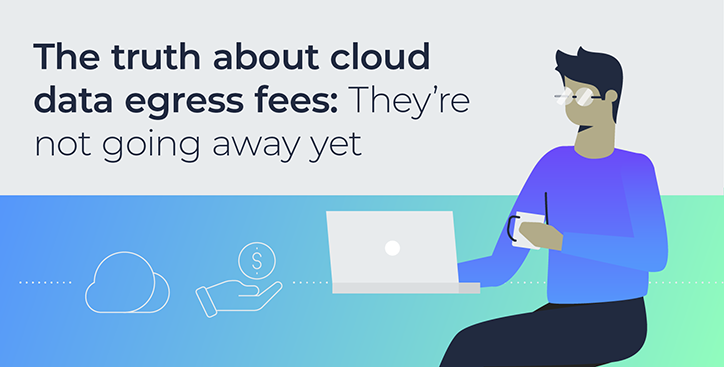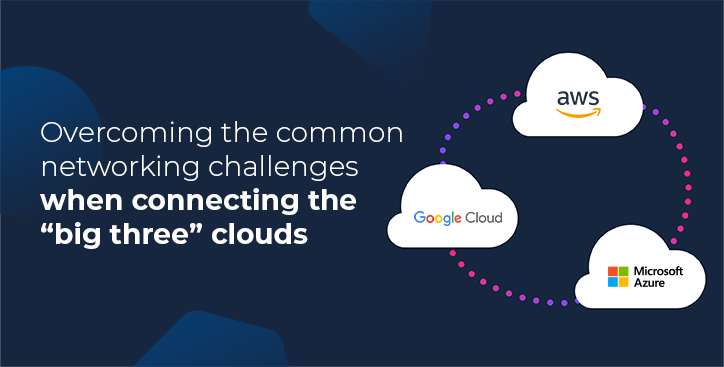The truth about cloud data egress fees: They’re not going away yet
By Alex Hawkes|5 April, 2024

It’s well understood that getting data into the cloud costs nothing. Depending on the route you take to engage with a cloud provider, there are dozens of free credits, allowances, and trial offers designed to make it easy to store your data with them.
Getting your data out of the cloud is an entirely different matter. And not just when we’re talking about permanent extraction and closing accounts. Simply pulling your data down to an external location, or moving it from one region or availability zone to another can cost you. Essentially, if your data leaves cloud storage and hits the internet, it triggers an egress charge.
These data egress fees are often referred to as ‘hidden costs’ because they are billed in arrears and are not always obvious to the inexperienced IT manager, meaning they are often not budgeted for.
Egress fees have also attracted so many complaints, because they make it prohibitively expensive to extract data, causing vendor lock-in, that regulators have begun to take notice, and the hyperscalers have begun to take action.
In the first quarter of this year, both Google Cloud and AWS have made similar announcements that suggest they will waive egress fees for companies migrating data out of their respective clouds to another cloud provider or even back to on-prem.
But the devil, as they say, is in the details, and while both the announcements from AWS and Google Cloud talk about removing data transfer (egress) fees and making cloud switching easier, the proposals come with terms and conditions you need to pay attention to.
Are hyperscalers making cloud switching easier by ditching egress fees?
Putting data into cloud storage or compute with one of the hyperscalers, has been likened to buying a plane ticket on a budget airline. The list price is just the basic starting point and you soon get hit with a myriad of additional charges for seat allocation, luggage, and priority boarding, or in this case for data tiering fees, API access costs, and transfer fees.
Before you know it, the cost has doubled or tripled, and other options look attractive. But by this point you’re invested and you realise that most of the alternatives behave the same way. This is what European regulators have picked up on in terms of the walled garden created by cloud providers, and what UK regulator Ofcom has proposed to investigate.
In fact, the issue has become so prevalent among hyperscalers that it’s been dubbed the ‘Hotel California effect’ - once you’ve checked into your cloud, you can never leave.
These actions by the hyperscalers are a step in the right direction for enterprises that are serious about parting company with their cloud provider and not being punished for doing so.
Especially with new regulations like the European Data Act on the horizon for September 2025, introducing measures aimed at protecting EU businesses from "unfair contractual terms" and allowing them to switch between cloud providers more easily and without the cost.
But egress fees remain one of the greatest, and most frequently surprising, cloud costs and should not be ignored.
Breaking down AWS and Google Cloud data transfer fee removal
Both the announcements from AWS and Google imply that the provisions are for one-way, permanent, movements. Google Cloud in fact stipulates that the customer’s account must be terminated after the data has been transferred out, and gives customers 60 days to complete the migration once the process has started.
The way egress fees are waived are in the form of credits applied to the final bill at the end of the 60-day window, and if the process does not complete for some reason within that time frame, a customer will have to restart the process at the end of the 60 days to get the credit.
AWS has taken a similar approach, also requiring a 60-day exit, and full removal of all data and workloads, although not necessarily account termination. AWS does note however that repeated requests for migration will face “additional scrutiny” suggesting repeated credit requests may be difficult to get signed off.
AWS does note however, that it has been providing 100 GB of free data egress per month since 2021.
But for now, data egress fees remain a very real consideration, and one that we have written about extensively, including the top 3 public cloud costs to watch and understanding cloud costs.
True costs of data egress from the cloud
Although each hyperscaler has its own pricing framework for egress fees, they will vary depending on the volume of data you’re moving and where it goes. Geography is also important to note. Transferring data between availability zones or within regions will result in lower fees, while transferring data across different regions or continents will present the highest fees.
To give some idea, the hyperscalers - AWS, Microsoft Azure, and Google Cloud - typically charge between 5 and 20 cents per GB every time you move data from their cloud instance to your private data centre or on-premises location.
While these fees are unlikely to have a big impact on smaller companies, large organisations moving terabytes around on a regular basis can get hit pretty hard.
There is however, a solid business case for internet-bypass solutions in the form of private network links that can help you cost-effectively migrate data out of and between clouds.
Using private connectivity to avoid egress charges
In this Console Connect webinar, Assessing the Real Cost of Egress, William B. Norton, an internationally recognised expert on internet peering, talked through his research which shows that if an enterprise exchanges enough cloud data to fill a 25Mbps connection on a monthly basis (roughly 7.72 TB of data), the cost of a private network can be entirely covered from the costs savings from reduced internet egress fees.
Norton goes into detail on the conversion between volumetric and metered cloud traffic expenses, but his summary is that it is provably less expensive to interact with your cloud over a private network when you have more than 25Mbps of traffic.
Beyond this, the cost of the private network is entirely paid for by the cost savings from the reduction in cloud internet egress fees, furthermore, the cost savings continue from this point forward towards a 40% cost savings on cloud internet egress fees.
The cherry on the top is that paying for a private connection will also improve your network performance in that you will have less latency, less jitter, and a more stable connection, and significantly increase security versus a public internet link.
One final consideration is that when using a Software Defined Cloud Interconnect (SDCI) like Console Connect, versus private cloud ports directly from your cloud provider - for Azure, you can purchase an ExpressRoute circuit; for Amazon it’s Direct Connect; and for Google Cloud it is Dedicated Interconnect - SDCIs are not restricted to a specific cloud provider or data centre ecosystem, and provider greater flexibility with cloud networking.
Console Connect enables users to spin-up Layer 2 and Layer 3 connections to all major cloud providers, including AWS, Google Cloud and Microsoft Azure, using our own high-performance global network.
The pay-as-you-go pricing structure gives businesses greater flexibility with their direct cloud connectivity.
Rather than having a long standing contract for a private connection or leased line with a set capacity to the cloud provider, with Console Connect you only pay for the time the dedicated link is active, as well as for data transferred out of the cloud, in some case making savings of between 30-40% on egress charges.

.jpg)





.jpg)

